Marginal Adaptation of In Vitro Class II Restorations Made Out of Bulk or Conventional Composite Using Single- or Multi-Layered Techniques
- PMID: 37763602
- PMCID: PMC10533156
- DOI: 10.3390/ma16186325
Marginal Adaptation of In Vitro Class II Restorations Made Out of Bulk or Conventional Composite Using Single- or Multi-Layered Techniques
Abstract
Objective: Testing the influence of various restorative materials (conventional or bulkfill composites) and filling techniques (single- or multi-layered techniques) on the in vitro marginal adaptation of large class II direct composites with supra and sub-gingival margins subjected to thermomechanical loading (TML). Methods: A total of 40 prepared teeth were attributed randomly to five experimental groups. In Group 1, restorations were made of multi-layered high-viscosity conventional composite (Tetric EvoCeram); in Groups 2 and 3, restorations were made of a high viscosity bulkfill composite (Tetric EvoCeram Bulk Fill) applied in one (Group 2) or three layers (Group 3); in Groups 4 and 5, restorations were made of a flowable bulkfill composite (SDR flow) applied in one (Group 4) or two layers (Group 5), covered with a layer of high-viscosity conventional composite (Ceram-X Universal). A single adhesive (OptiBond FL) was used in all groups. All specimens were submitted to a staged TML comprising three phases (2 × 500,000 and 1,000,000 cycles) at 50 N with 3350 thermal cycles (5 to 55 °C) every 500,000 cycles. The tooth-restoration interfaces on proximal surfaces were evaluated quantitatively by scanning electron microscopy, before and after each TML phase, hence at three timepoints (T0, T1, T2 and T3). The following segments were considered for evaluation: proximal, vertical enamel margins (assessed individually on both restoration sides), cervical enamel (restoration side above CEJ) and cervical dentin margin (restoration side below the CEJ). Results: TML induced a significant reduction in continuous adaptation at both enamel and dentin margins in all groups, with percentages of continuous margins ranging from 75.2 to 91.8% at T0, and decreasing to values ranging from 21.3 to 73.9% at T3. Both composite systems and layering protocols had a significant influence on marginal adaptation of the restorations, with statistical associations depending on the restoration group and the timepoint considered. Defective margins in enamel were all of a cohesive nature with micro-fractures, while in dentin, interfacial gaps were the main defect observed. Conclusions/Clinical significance: The present results highlighted significant degradation of marginal adaption after long-term in vitro fatigue test using materials even with high-viscosity conventional resin composites, applied with a proper layering approach in medium-large sub-gingival cavities. While no significant differences were observed at the dentin cervical margins, there was a tendency for better adaptation at the enamel margin when using a higher modulus material with a multi-layered technique.
Keywords: bulkfill; class II; marginal adaptation; resin composite.
Conflict of interest statement
The authors declare no conflict of interest.
Figures
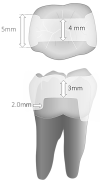





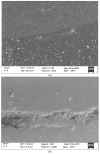
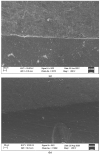

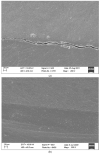
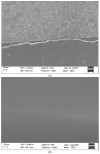
Similar articles
-
In vitro evaluation of marginal adaptation in medium- and large size direct class II restorations using a bulk-fill or layering technique.J Dent. 2021 Dec;115:103828. doi: 10.1016/j.jdent.2021.103828. Epub 2021 Oct 20. J Dent. 2021. PMID: 34678337
-
Marginal Adaptation of Flowable vs Sonically Activated or Preheated Resin Composites in Cervical Lesions.J Adhes Dent. 2022 May 16;24:247-257. doi: 10.3290/j.jad.b3032461. J Adhes Dent. 2022. PMID: 35575657 Free PMC article.
-
Marginal adaptation of class II cavities restored with bulk-fill composites.J Dent. 2014 May;42(5):575-81. doi: 10.1016/j.jdent.2014.02.007. Epub 2014 Feb 18. J Dent. 2014. PMID: 24561041
-
Deep proximal margin rebuilding with direct esthetic restorations: a systematic review of marginal adaptation and bond strength.Restor Dent Endod. 2022 Mar 4;47(2):e15. doi: 10.5395/rde.2022.47.e15. eCollection 2022 May. Restor Dent Endod. 2022. PMID: 35692223 Free PMC article. Review.
-
A Comprehensive Review of Treatment Plans for Marginal Enamel Fractures in Anterior Teeth.Biomimetics (Basel). 2024 Dec 18;9(12):770. doi: 10.3390/biomimetics9120770. Biomimetics (Basel). 2024. PMID: 39727774 Free PMC article. Review.
Cited by
-
Influence of Cavity Lining on the 3-Year Clinical Outcome of Posterior Composite Restorations: A Randomized Controlled Clinical Trial.Dent J (Basel). 2024 May 7;12(5):128. doi: 10.3390/dj12050128. Dent J (Basel). 2024. PMID: 38786526 Free PMC article.
-
Kinetic of Light Transmission during Setting and Aging of Modern Flowable Bulk-Fill Composites.Materials (Basel). 2024 Aug 30;17(17):4292. doi: 10.3390/ma17174292. Materials (Basel). 2024. PMID: 39274681 Free PMC article.
-
Profiling Elastoplastic and Chemical Parameters to Assess Polymerization Quality in Flowable Bulk-Fill Composites.Bioengineering (Basel). 2024 Feb 5;11(2):159. doi: 10.3390/bioengineering11020159. Bioengineering (Basel). 2024. PMID: 38391645 Free PMC article.
-
SEM Evaluation of Marginal Adaptation E-Max Crowns Manufactured by Printing-Pressed and Milling.Diagnostics (Basel). 2023 Nov 23;13(23):3518. doi: 10.3390/diagnostics13233518. Diagnostics (Basel). 2023. PMID: 38066759 Free PMC article.
-
Evaluation of Marginal Adaptation of SDR Plus, Fiber-Reinforced and Nanofilled Composites in Endodontically Treated Teeth: A Scanning Electron Microscopic Study.Cureus. 2024 Oct 3;16(10):e70745. doi: 10.7759/cureus.70745. eCollection 2024 Oct. Cureus. 2024. PMID: 39493132 Free PMC article.
References
-
- Van Ende A., De Munck J., Lise D.P., Van Meerbeek B. Bulk-Fill Composites: A Review of the Current Literature. J. Adhes. Dent. 2017;19:95–109. - PubMed
LinkOut - more resources
Full Text Sources
Miscellaneous

